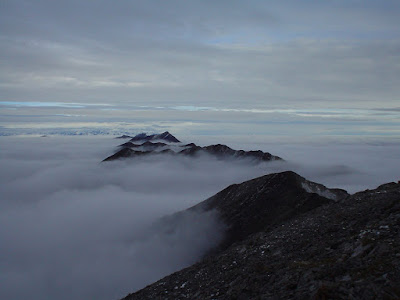Like the questionable quasi-sacred practices of mendicant monks and friars out to fatten their own pockets selling the Church-unsanctioned 'indulgences' to gullible Christians, we were made aware, as we sat along with young acquaintances, both Japanese and European, that we could access Buddhist prayers in an offering to the Temple's guests. We were seated at a long refectory-style table set in the Japanese style awaiting dinner and it was served by smiling young monks, tonsured and clad in attire common to figures of faith in any religion.
Given a piece of washi to write down the subject of our preferred prayer and whom it would benefit, the fee transferred, a sense of tranquil satisfaction washed over us, and we turned to the meal being presented, starting with a bowl of Miso soup on top of which floated a raw egg.
We were in a Zen Buddhist temple, a compound set high on a prominence overlooking a small town. We would be staying there for several days. Later, in the evening, I would be seated on a small stool in a large chamber the focus of which was a pool, and this was a public bath. It was women's hour, and while on the stool I used a basin of clear, cool water and soap to thoroughly cleanse myself. It was only then that I could enter the pool and experience the comfort of the water's warmth, alongside another handful of women whose presence was sparse in the expansive pool.
 |
|
We slept on futons that night, my husband and me. In the tiny chamber which was ours for the length of our stay, furnished as frugally and subtly artistically as only Zen Buddhism knows how to present, was a scroll, its legend in Katakana script, the brush strokes, fluid and casual, of a bird seated on a melon upon whose vine curling about the scroll sat other, smaller birds. Only a small, low table occupied the room where we were served tea as we sat on tatami mats.
We were there with a group we had joined, of young Japanese and their European counterparts, adventurers curious about other parts of the world, working as teachers of English at various schools and colleges. We were the oldest, the only married couple. Most of our trips as a group focused on hiking expeditions in forests outside the great sprawling city of Tokyo. To access those forests close to small towns and villages we had to take a combination of public transit; buses, trains, subways. My husband knew his way around.
While at the Temple compound we took walks early in the morning just as mist began clearing under the influence of the intense sun. The most prominent path led from the temple complex down to the village, a walk of roughly a half-hour, though looking down at the village from the height of the Temple complex, it looked much closer. On the way, we would pass a part of the Temple complex where the monks were housed, and at that time of the morning the heavenly sound of a chorus of sacred music sung by a choir of quietly restrained voices followed us as we meandered along. It seemed otherwordly.
Much earlier, at the crack of dawn, we had the option of attending the first prayer of the day in a large chamber where monks and guests were seated on the floor on their haunches as the melodic, slow-paced, low-voiced prayers commenced. It takes a limber body to be seated for such a prolonged period in that respectful pose, attentive to the proceedings.
As we walked along, the two of us, enveloped in a feeling of having somehow managed to travel back in time to another era, certainly another country than that we were born to, immersed in another culture, we thought how quaint it was to see young tonsured, cassocked monks driving past, genially waving and smiling at us, in their BMWs.
We two wandered at leisure through the monastery's hill-sloped gardens along stone pathways lined with tiny Jizo statuettes. Some of them held children's toys, were dressed like infants. Jizo is a revered Bodhisattva, the patron saint of travellers, but perhaps more importantly the protector of the spirits of children who have died. The tiny statuettes were everywhere displayed, hundreds of them. It was not by any means the only place where we saw them, poignant and appealing, the champions of tiny lost souls, particularly children who had died prematurely.
The monastery was a place of quiet tranquility. I recall walking through a corridor linking buildings fully open to the out-of-doors, fully similar to medieval churches' cloisters, how much the landscape and the buildings themselves made me feel as though I was living in a similar landscape I inferred from the Name of the Rose. But while living there, in Japan, it was the great novel by Murasaki Shikibu, The Tale of Genji, that made the greatest impression for the monastery, like the novel in all likelihood reflected the medieval world in the modern era.
































/https://www.thespec.com/content/dam/thespec/opinion/editorial-cartoon/2020/05/27/editorial-cartoon-for-may-27/_20200527.jpg)